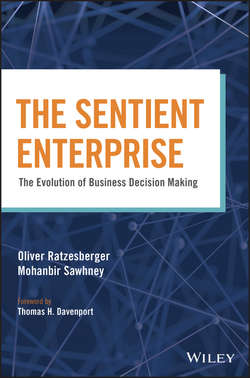Читать книгу The Sentient Enterprise - Ratzesberger Oliver - Страница 3
На сайте Литреса книга снята с продажи.
Foreword to The Sentient Enterprise
ОглавлениеThe Sentient Enterprise is both a good book and a good sign. Let me explain each component of that proclamation further.
It’s a good book because two very smart and experienced gentlemen collaborated to produce some excellent advice on data and analytics. I’ve known both authors for over a decade, and they are, individually and collectively, powerful thought leaders.
Individually, either of these fellows could write an excellent book (and Sawhney has already written several!). Oliver Ratzesberger is one of the most visionary thinkers today on IT architecture issues. I was dazzled by the data architecture he created at eBay, and he’s risen quickly to be the head of product at Teradata. That affiliation doesn’t mean that he only espouses Teradata solutions; he’s long been a strong advocate of open architectures and open-source tools like Hadoop.
Sawhney, trained as a marketing professor, is clearly much more than that. He’s been a leading thinker for many years in the areas of innovation, digitization and e-business, networked organizations, and many other topics. If you were looking for a coauthor to think strategically about technology, you couldn’t find anyone better than Mohan.
Collectively, the authors’ expertise yields a unique set of topics that appeal to both strategists and practitioners – each of whom have an important stake in the journey toward sentience. One moment you’re reading about how the massive explosion of data will reshape business and society. The next thing you know, you’re learning how to prevent uncontrolled proliferation of virtual data marts with time-limited lifespans, or the correlation between call duration and customer sentiment in call centers. No one could accuse these authors of dwelling solely in either the strategic or the tactical realm.
The Sentient Enterprise is also a good sign that analytics are becoming a mainstream, professionally-managed activity – at least if organizations practice the lessons in this book. Historically, the creation of analytics was a somewhat unstructured and “artisanal” activity, driven by individual human hypotheses and curiosity. The analytical outcomes might be implemented by a decision maker, or they might not. There was no vehicle for embedding them into business processes and systems, or for learning from them across the organization.
But with the five “platforms” described in this book, analytics can move well beyond the artisanal stage. They are a linked set of capabilities for making analytics operational, production-based, and shared across the enterprise – a high-volume manufacturing operation for data and analytics-based decisions. They suggest a future – and a present in a few companies – in which analytical decisions are produced automatically and embedded into decisions and actions without much human intervention. For anyone who believes as I do that analytical decisions tend to be more accurate and less biased than those based on “the gut,” this is great news.
These approaches won’t be adopted for all decisions, at least not for a while. They currently apply to repetitive and tactical decisions based on a lot of data – much of it Internet-based “behavioral data,” as Ratzesberger and Sawhney refer to it. In advertising, for example, versions of the platforms are already being used to support digital marketing decisions. But they won’t be applied to decisions about Super Bowl ads anytime soon.
It’s also important to remember, as the authors point out, that these platforms aren’t just based on technology. Platforms consist of both technical and human capabilities. If you want the technical capabilities to succeed, you need a set of human skills, behaviors and attitudes that will make them possible. These human factors come into play both at the executive level – supporting development of the technical capabilities and their fit with business processes – and at the front lines as well.
In health care, for example, we desperately need approaches to “precision medicine,” and they will require all of the five platforms that these authors describe. But part of those platforms are senior managers who are willing to sponsor the development of the platforms, and doctors and nurses who are willing to use them and work with their recommendations and decisions on a daily basis. It’s anybody’s guess whether developing the technological or the human capabilities will be more difficult, but both will be hard.
So get busy and start building these five platforms if you haven’t done so already. Absorb both the strategic and tactical advice in this excellent book. And start preparing the wetware in your organization for a future in which analytical decisions are produced like high-quality widgets.
Thomas H. Davenport
Distinguished Professor, Babson College
Fellow, MIT Initiative on the Digital Economy
Author of Competing on Analytics and Only Humans Need Apply
